The Checker Maven
The World's Most Widely Read Checkers and Draughts Publication
Bob Newell, Editor-in-Chief
Published each Saturday morning in Honolulu, Hawai`i
Contests in Progress:
Tonkin

Tonkin is what the French called the northern sector of Viet Nam, during the years of French occupation of that Asian nation. They derived Tonkin from the Vietnamese term Đông Kinh, which actually means "Eastern City" (not northern), and is also an old name for the Vietnamese capitol city, Ha Noi. Đông Kinh additionally is used to refer to the cities of Tokyo and Beijing. We found that the Internet contains a fair amount of incorrect information about the name Tonkin, so we hope we have set the record straight, at least to some degree.
Of course, while The Checker Maven's excellent and erudite Research Department is always anxious to impart collateral learning such as this, today's column really is about checkers, as we present another lesson in our Checker School series, a position, unsurprisingly, credited to a certain H. Tonkin. We don't know anything about Mr. Tonkin, but we're convinced that he didn't come from Ha Noi, though his origin might well have been in an eastern region of some other nation. The setting is a very practical endgame, and for a change in this series you'll find the solution is neither long nor especially difficult.
WHITE

BLACK
Black to Play and Win
B:W21,17,10:BK26,14,2.
Whether you're from the east or the north, or for that matter, somewhere else, work out the solution and then travel to Read More để xem các giải đáp cho bài (to see the solution to the problem), notes, and a sample game.![]()
A Double Boomerang

We usually think of Australia in conjunction with the boomerang, which in turn we usually think of as a device which, when thrown, will tend to return to the thrower after describing an extended aerial arc. Of course, that's the usual public over-simplification, but it is known that boomerangs were used in Australia at least ten thousand years ago. A boomerang is actually a rotating wing, and it's an example of a "heavier than air" aerial device; you might even think of it as a very distant forerunner of the airplane.
But if you want to know all about aerial boomerangs, we'll direct you elsewhere. Today's Checker Maven column, in our series taken from Willie Ryan's Tricks Traps & Shots of the Checkerboard, is about a boomerang of a different sort. Yes, indeed, checkers has its own variety of boomerang, though it doesn't have an Australian history. Willie will explain below.
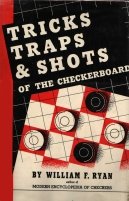
"As the name implies, a boomerang shot defines a situation wherein the first player, in executing a shot, uncovers a counterstroke for the second player. Such examples are fairly common, but double boomerangs, in which the mechanical process of a straight or single boomerang occurs twice in succession, are so rare they are considered oddities. The following game illustrates one of the very few practical double boomerangs, in which 16 pieces are removed from play in a hectic series of doubles and triples.
| 9-13 | 5-9---A | 6-10 |
| 23-19 | 29-25 | 28-24 |
| 11-15 | 10-14 | 1-5---B, 1 |
| 22-18 | 27-23 | 32-28 |
| 15-22 | 8-11 | 3-8 to the |
| 25-18 | 24-20 | diagram. |
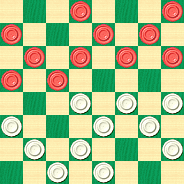
WHITE
White Plays; Black Draws
W:W31,30,28,26,25,24,23,21,20,19,18:B14,13,12,11,10,9,8,7,5,4,2.
A---Here is an old shot that Alfred Jordan used with stunning effect in his exhibition play, when handling the white pieces: 7-11, 19-15, 10-19, 24-15, 6-9, 26-23, 1-6, 29-25, 12-16, 31-26, 3-7, 28-24; at this position, 8-12 or 16-20 will produce the draw, but 16-19, 23-16, 11-20 will be smashed by 25-22, 9-14 (nothing better), 18-9, 5-14, 27-23*, 20-27, 15-10, 6-15, 23-18, 14-23, 26-3, a double exposure, and white wins.
B---This leads to a hazardous ending. Better play would be: 3-8, 25-22, 1-5, 32-28, 11-15, 18-11, 8-15, 19-16, 12-19, 23-16, 14-17, 21-14, 9-25, 30-21, 13-17, 21-14, 10-17, 26-23, etc., for a draw."
1---Here's the difference between human and computer analysis. The computer actually favors the text move, 1-5, by a slim margin; but the computer doesn't take into account how difficult it might be to thread your way through the ensuing ending, which Willie rightly characterizes as "hazardous." For a human player, trying to find the right moves over the board with the clock ticking, Willie's idea of playing 3-8 instead makes a lot of sense.
We're not sure if this is really a problem or an exercise; it's more in the nature of a study. In any case, decide how you would play this out, and then, click on Read More to circle around to Willie's high-flying line of play.![]()
The Leaves Fall Quickly in the Fall

How fast do the leaves fall in the Fall? It seems like the season is all too brief. There is a short period of spectacular color and then, suddenly, it's over, and in much of North America we're left with nothing but a big raking and cleanup task.
For our October speed problem, we've chosen to mimic the season by presenting a problem which goes by pretty quickly. One minute the clock starts, and then, seemingly in seconds (actually it is in seconds), time is up.
Of course this means that the problem is in the easy category (and we've seen problems like this before), so we'll expect you to solve it in 15 seconds. When you're ready, let your mouse fall on the link below.
October Speed Problem (easy; 15 seconds)
To drop down to the solution, simply flutter over to Read More.![]()
The Online Museum of Checkers History
Do you suppose that this is the general public's idea of a Checker Museum?

Unfortunately, much of the general public has these kinds of inaccurate ideas about the game of checkers; and since the untimely fire at the International Checker Hall of Fame in Petal, Mississippi, there hasn't been a true checker museum in operation to set forth the truth of the matter.
At least, not until last year, when the high-tech alternative, The Online Museum of Checkers History opened its virtual doors.

OMOCH, as it is often abbreviated, is the product of the labor of Jay Hinnershitz, Liam Stephens, and Ken Lovell, a trio of checker experts and historians determined to save valuable artifacts of the game of checkers and make them available on the internet to the worldwide community of checker enthusiasts.


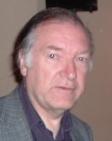
Jay, Liam, and Ken
The OMOCH business model is simple and practical. Contributors submit photos or scans of their checker memorabilia, and OMOCH presents them in an attractive on-line format. Look, for instance, at this incredible photo of a young Gonotsky and an even younger Willie Ryan, with J. G. Finley looking on. It's one of dozens of such exhibits found on the OMOCH web site.

Jay Hinnershitz is the primary architect of OMOCH, and he granted The Checker Maven an exclusive email interview. We asked Jay a number of questions about the museum, its background, its future, and how it came to be. (Jay asks us to point out that the opinions he expresses are his alone and are not necessarily OMOCH editorial positions or the views of the other OMOCH editors.)
What gave you the idea for the Museum?
The forerunners of the OMOCH were my "The History of a Book" and "From Earl Hangen's Scrapbook" posts on the ACF Forum. Earl's entire collection of books, boards, photos, etc. were either auctioned off, or were going to be trashed. I got my hands on most of his collection, and wanted to share with the rest of the checker playing community. I could do this best by posting on the ACF Forum.
By the way, Earl Hangen is a personal hero of mine; not a macho man, never anything more than a very humble, hermit type of guy; but, up until recently, he lived his life in exactly his own way ... the way he wanted to ... what more could any man ask for ??
The idea for the museum began when I kept having trouble posting on the ACF Forum. Something was wrong with Forum, and it was not fixed for several months. Posts were being truncated, and no reasoning was being given. Liam was having the same trouble. I thought about starting a website then, and was kicking the idea around. Then when Kim Willis (the current ACF treasurer) proposed something on the ACF Forum about starting something to replace the recently destroyed ICHF, I just took her idea a step further. The seed was already planted; Kim was the water that made it grow. When Liam agreed, it was full speed ahead.
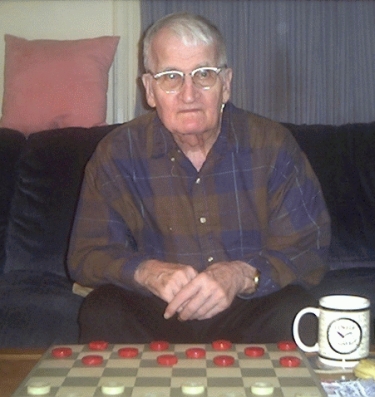
Earl Hangen
What are the Museum's goals?
Just as the slogan says: "Promoting the Future of Checkers and Draughts, by Glorifying its Past !" There is no other site on the web devoted exclusively to this concept (for our version of the game, anyway).
I knew the Beijing games were coming up, and that these games might generate some public interest. I wanted to have available, for anyone interested , the chance to see that, "Yes, the game does have a recorded history."
This will, I hope, help with the notion that there is still some pride amongst the players and/or organizers of the game, to the general public, as opposed to the concept that Schaeffer (architect of Chinook) created with his "Checkers is Solved" campaign, which caused a public and media denouncement of the game.
Checker material is getting harder and harder to find. Did you ever expect to be able to pull together such a large and growing collection, such as you now have online?
I agree that it is getting harder and harder to find Checkers/Draughts related material. I am very proud of the material that the OMOCH has on display. But, I am disappointed in knowing that there are many large collections of historical items out there, but the owners won't display them, either here or anywhere else.
I have statement from one major historian on the game that he , alone, could "triple the contents of the site" and yet would not contribute one single item. And, I have had many promises of items and exhibits, that quite simply, were not kept...so, what are you going to do?
I have more, Ken Lovell has wrote that he has more, and Liam just wrote me that he has several un-opened boxes (!) of material. So, just between us OMOCH Editors, we will have more; but I would still like to see more submissions from the community. Perhaps potential submitters are too modest, or think their items won't be used.
As I stated in the OMOCH submissions page, we are not looking for things of great monetary value, but something that maybe captures a moment in time. And, maybe even a personal Checkers/Draughts related moment in time. Maybe you still have the board you played your first game on ... send it in, we will use it !!

Classic Checker Set
How much time you estimate you spend working on the Museum each month?
I am still, three years after the fact, going through Earl Hangen's collection and finding things to use on the Museum part of the site. I am constantly searching for historical info from my library of books. This, on top of the time I actually spend editing the site, puts me up there in hours. I have had a few down weeks , but for the most part, between 10-15 hours a week. I have already done weekend marathon sessions on the site where I placed 20 hours editing between Friday and Sunday Nights. And,I am always looking for mistakes and correcting them .
Do you get a good audience?
Not the audience I expected; again, there are many I hoped to hear from and (have) contribute.
But, I have heard from the great,great, great granddaughter of Henry Hutzler, the daughter of Rudy Munzinger, the grandson of Fred Vore, the granddaughter of Paul Ottey, the granddaughter of Rex Wood ... this is amazing! People that just googled their ancestor's names, and ended up on the OMOCH, and write me thanking me for remembering the parents, grandparents, etc. This alone makes the effort worthwhile, although the main purpose is to promote the game.
The low point was receiving an e-mail form the official ACF court jester (oh, I am sorry)--- the official ACF appointed website journalist--- condemning the site, insulting the editing and/or editors, and generally "telling me off" as my son, who read the e-mail, explained it to me. Some people, eh?
How do you and your collaborators divide up the effort?
Why ... do you have some spare time on your hands ? (laughs) I have given free reign to both Liam and Ken to do as they please. I rarely, if ever, edit their work, only to correct a typo I might find. And, I have been doing the formatting for the exhibits, and writing the descriptive text.
Liam did almost all of the 1980-2000 Timeline entries himself; Ken made many image and info additions to the earlier timelines. Whatever strikes them, they can do. I am always available for technical help, and if I cannot figure it out, I have my son, who has assisted greatly in this capacity.

What are the directions in which you'd like to take the Museum in the future?
Just keep on going, trying to show the world the history of the game as we know it.
I am concerned. I have read on the ACF Homepage that Charles Walker is planning to start work on the ICHF again. (BTW, it needs to be mentioned that the OMOCH is not affiliated with the International Checker Hall of Fame, although at the launch of the OMOCH, I was forwarded a letter of support from Walker.) I wonder if some are saving their items to donate to the ICHF when it gets up and running, because several that publicly, openly, promised to submit some items never have.
Do you have any thoughts about where the game of checkers is headed?
Without fanatical fresh young American blood, the game could be in trouble over here in America. Definitely, the Internet has piqued the curiosity of some younger players, who have tried it and found out that there is more to the game than "meets the eye," or more than what is portrayed by the news media, i.e., that the game is played by old men, or that it is "solved" --- nothing more to it than a game of Tic-Tac-Toe. This is the result of the Schaeffer publicity campaign, that being that the game is no longer being compared to Chess, it is now being compared to Tic-Tac-Toe.
I have actually heard this stated: "Checkers is played by kids whose parents cannot afford to buy them any more at Christmas time than a two dollar set of checkers." This type of thinking must be changed, or the game's organizations will be in trouble.
Do you have any ideas about how it might be revived?
Yes: we need to make superstars of the young players, make the recognition they receive something that is coveted by all the other young players, such as it is for other celebrity/sports/music etc. superstars. Then more and more will want it ... make being the best player something they all want ! Make the championship something they want!
Look at what Ron King did for the game in Barbados. He is a SUPERSTAR, and the game thrives there because the kids want what he has.
Incidentally, pushing stardom on a youngster could be a problem. One example: last year, I threw some kudos and accolades to young Colton Cardie on the ACF Forum, and immediately, another of the American youth came and threw insults and questioned the legitimacy of Colton's accomplishments, probably jealous of the recognition that Colton was receiving. In my mind, the ACF should have jumped in there and tried to promote a match there between the two. The winner would have had some bragging rights, and that is what this game needs; some fanaticism about playing and winning.
We may, initially in such a campaign, have to compromise certain qualities, and behavior, that is expected from the youth, meaning common courtesy, respect and decent behavior. But, hey, they really don't have these qualities anyway. I don't see a problem with making a sacrifice of something that really does not exist, even within a lot of the "adult" members of the checkers/draughts playing fraternity.
One example of this lack of civility: Ron King's statement that he "is going to destroy Alex" from a few years back. The only thing that actually prevents him from making this statement again is that Alex destroyed him in their two 3-move matches. But it did not stop him from making negative remarks about Kondlo after their Freestyle match last year. If we can excuse the champions for this kind of behavior, then we need to get over the notion that the younger blood, the true "future of the game," has to behave like little angels in order to get support from the game's organization. This I stand behind very strongly !

Tinsley and Langon, Lakeside 1975
Who do you think was the greatest player in checker history?
Marion Tinsley, if for nothing more than his amazing list of accomplishments. More amazing is that he was head and shoulders above all other players at a time when grandmasters roamed the country, looking for tournaments to win. He played them all, and beat them all
The greatest player today?
Alex Moiseyev, without a doubt. In fact, I believe the only thing that prevents him from ever having a chance of being one of the greatest players ever is the lack of serious grandmaster competition available to him.
Do you play a lot of competitive checkers yourself?
Not since my last sojourn into Mail play, in the mid-to-late 1990s. I play on Yahoo occasionally; I play a few crossboard games with Earl Hangen. I enjoy the game as I see it: solving some problems, playing through some games while doing my research for the site and the like. I will, eventually, get to the point where I am content with the OMOCH site, the children will be grown and out of the house, etc. I will then study again, with an attempt at some crossboard tournaments. It will happen, just cannot say when.
Anything you can tell us about Jay the person?
Married, father of two with a step daughter, youngest of nine siblings, Christian, German parentage ,truck driver, musician (drums), artist (pen and Ink fantasy type work), very much American, very much male, checkerist.

The Checker Maven thanks Jay for his extensive commentary. We hope you enjoyed reading about OMOCH and will be inspired to pay a virtual visit soon.
Of course, no Checker Maven edition is complete without a game or a problem, and so we'd like to pass along one of Jay's best. It's a game he played himself, and here's what he has to say about it.
"It is the first game I ever won during my days as a mail player, from 1986. It was contested against Dan McGrath, from the Bethlehem, PA. area, during the 1986 ACF District 3 mail tourney. McGrath was a former American Mail Play Champion, and was well known and respected for many years, by even such as Dick Fortman, who met McGrath at the 1958 US National in Bethlehem, PA.
Anyway, as I played most of my mail games 'cross board' style, most of them went into the wilderness very early ... not that I was trying to lead my opponents this way. I just always (at the time) considered my mail games as practice for the eventuality of my becoming a crossboard player.
I remember showing this to Earl Hangen at the time, and he congratulated me. He wrote me that 'to win a game from McGrath is more than I (Hangen) have ever done, and I have played him many times.'"
Black: Jay Hinnershitz
White: Dan McGrath
11-15 23-19 9-13 22-17 13x22 25x11 7x23 26x19 8-11 27-23 5-9 29-25 9-13 25-22 11-15 24-20 15x24 28x19 4-8 30-26 8-11 19-16 12x19 23x7 2x11 22-18---A
A---22-17 would have drawn.
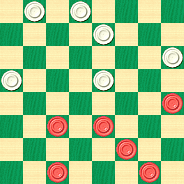
BLACK
Black to Play and Win
B:W32,31,26,21,20,18:B13,11,10,6,3,1.
Visit the Museum first; next, solve the problem; after that, click on Read More to see the solution; and finally, visit the Museum again. There's a lot to see and we're sure you didn't catch it all the first time.![]()
One Thousand and Four
We're certain you'll be interested to know that 1004 is the Heptanacci number for n=12.

And that the "1004 Penthouse" is a popular economy lodging spot in Patagonia.

And that in the year 1004, Henry II of Germany became Holy Roman Emperor and a long war started almost at once.
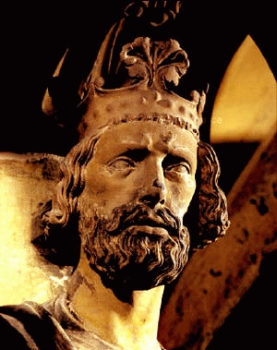
In the world of checkers, though, there is problem number 1004 in Gould's Problem Book, and rather than further considering mathematical series, Argentine hostels, or medieval wars, we'd like to turn our attention instead to Ben Boland's detailed study of this difficult and controversial problem and its variants, which he in turn attributes to a William M. Courtney. As a lesson in our Checker School series, this one is long and demanding, but very much worth the effort.
Below we present six positions. It will take you some time to work through them all. When you've done so--- and no slacking, now!--- you can click on Read More to see the solutions, detailed notes and explanations, and numerous additional variations. Don't expect to finish up in an hour, or even a day; there's a lot of material here. We've quoted directly from Ben Boland's Famous Positions in the Game of Checkers.
A position by T. B. Murphy as No. 1004, Gould's Problem Book, Page 353, with solution on Page 367. A note on Page 375 says: "A very fine problem; the advantage of the Bridge and the King on 18---2 are sufficient to balance the inequality of pieces."
| For consistency, Black is at the top in all positions | ||
| T. E. Murphy No. 1 | H. Morrall No. 2 | A. McGill No. 3 |
| BLACK | BLACK | BLACK |
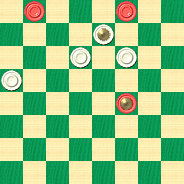 | 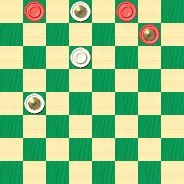 | 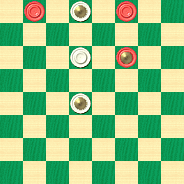 |
| WHITE | WHITE | WHITE |
| White Plays --- Drawn | White Plays to Win | Black Plays --- Drawn |
| W:WK7,10,11,13:B1,3,K19. | W:WK2,10,K17:B1,3,K8. | B:WK2,10,K18:B1,3,K11. |
| L. J. Vair No. 4 | J. Searight No. 5 | F. Dalumi No. 6 |
| BLACK | BLACK | BLACK |
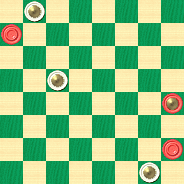 |  | 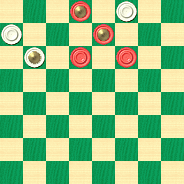 |
| WHITE | WHITE | WHITE |
| White Plays --- Drawn---1 | Black Plays --- Drawn | Black Plays to Win |
| W:WK1,K14,K32:B5,K20,28. | B:W1,3,K27:B6,10,11,14. | B:W1,3,K27:B6,10,11,14. |
1---The position was originally, and incorrectly, published as "White Plays to Win"---Ed.
2---An evident misprint; the King obviously is on 19, not 18---Ed.
![]()
Secret Hideaway

Don't tell anyone, but The Checker Maven has a secret hideaway.
Unfortunately, it isn't a bungalow tucked away on a remote tropical island, much as we might wish; but for a checker fan, it might be something even better: we have a hidden stash of checker problems.
No, we're definitely not telling. But in our weekly columns, little by little we'll share some (maybe even all) of the contents of our secret checker problem hideaway with you. Today, we'll start with a deceptive little situation of the "what result?" variety. Take a look at the diagram below.
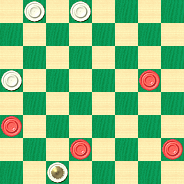
BLACK
Black to Play, What Result?
B:W32,31,20,K3:B17,12,7,5.
We can't offer a week's vacation in Paradise as a prize for solving this one; we can only promise you self-satisfaction and a feeling of accomplishment. Tease out the secret and then click on Read More, which will reveal the solution's hideaway.![]()
Labor Day Race, 2009

The runners above are taking part in an event called the Saguaro Race, held on Labor Day weekend in Arizona. There's a choice between a more serious eight-mile event, or a two-mile "fun" event. Given the heat of the Arizona desert, and our less than stellar endurance, we know which one we would opt for--- but to each his own, and we're certain that a good time will be had by all.
As our own celebration of Labor Day, the holiday set aside for recognizing the ordinary worker who makes America great, we offer our own race, and we promise that it's much less taxing than the Saguaro event. It's a race against the Javascript clock to solve a checker problem before time runs out. The problem will tax your brain, but not all that much, so we'll give you 30 seconds to figure it out. (The Saguaro participants, no matter which event they choose, can't possibly finish that fast!)
Click on the link below to display the problem, then come back and click on Read More to see the solution.
September Speed Problem (moderately easy, 30 seconds)
![]()
Back to School, 2009

Yes, it's that time of year again, when to the general dismay of young folks everywhere, school opens again for another seemingly endless academic year. We counsel students to take courage and persevere--- it isn't really all that bad, and you will be repaid many times over in the years to come.
Our continuing Checker School lessons also offer much reward, and the effort involved is most enjoyable. This month, as we continue with studies drawn from Ben Boland's Famous Positions in the Game of Checkers, we look at three positions that seem unlike each other, but have a definite relationship that you'll understand as you study the solutions and notes.
In Mr. Wardell's study, Black has even material but a position that looks hard to defend, yet somehow must manage to draw
WHITE
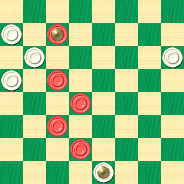
BLACK
Black to Play and Draw
B:W28,24,21,20,K2:BK27,19,15,11,7.
In the second study, by Mr. Grey, Black is a piece down and seems to need a miracle.
WHITE
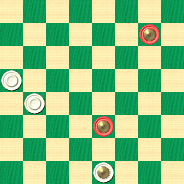
BLACK
Black to Play and Draw
B:W20,16,K2:BK25,K10
In the final study, by Mr. Hennigan, Black has even material but a rather tough-looking position, yet the draw is there.
WHITE

BLACK
Black to Play and Draw
B:W30,29,K24:B27,23,22.
Spend some time on these; after all, good lessons require effort! When you're ready, click on Read More for the solutions, sample games, and detailed study notes.![]()
Monty's King-Pinch

In the English language, the word "pinch" has a couple of different meanings. The young lady above is demonstrating the most common meaning, pinching her cheeks in a manner that we're sure she finds amusing. But today, we're going to consider another meaning of the word, namely, "to steal."
In our continuing series of excerpts from Willie Ryan's famous book, Tricks Traps & Shots of the Checkerboard, Willie talks about Monte Schleifer's clever way of stealing, or pinching, a king, via a most interesting stratagem. Willie tells us more below.

"When I was a schoolboy of 13, I learned that the City College of New York had organized a checker club for students, and were holding weekly meetings every Friday afternoon. On my initial visit to this club, I had the pleasure of meeting for the first time Monte Schleifer of Brooklyn and Jack Cox of the Bronx. Today, they rank high among the nation's leading player-analysts. As a special contribution to this book, Monty offers this attractive morsel of brilliant play, showing a clever drawing idea. For the diagram, move:
| 11-15 | 10-14---A | 4-11 |
| 24-19 | 27-24 | 24-19 |
| 15-24 | 16-20 | 6-10 |
| 28-19 | 31-27 | 29-25 |
| 8-11 | 7-11 | 12-16 |
| 22-18 | 19-15 | 19-12 |
| 11-16 | 2-1---B | 10-15. |
| 25-22 | 15-8 |
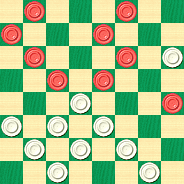
WHITE
White to Play and Draw
W:W32,30,27,26,25,23,22,21,18,12:B20,15,14,11,9,7,5,3,1.
A---The following unusual shot came up in a mail game between Joseph Viera of Nantucket, Massachusetts, and Fred Butterworth of Passaic, New Jersey: 4-8, 22-17, 8-11, 17-13, 16-20, 26-22, 11-16, 29-25, 9-14, 18-9, 5-14, 22-18, 14-17, 21-14, 10-17, 31-26, 7-10, 18-15, 3-8, 23-18, 16-23, 26-19, 17-22, 25-21, 10-14, 18-9, 1-5, 15-11 (what's going on here?), 8-31, 30-26, 5-14, 26-1; a draw. A well-played crossboard game.
B---Strongest, but 4-8, 29-25, 2-7, 24-19, 7-10, 32-28, 12-16, etc., also seal the draw."
Can you figure out how Monty pinches a king? When you've worked out your solution, click on Read More to let Willie show you how it's done.![]()
Smaller Than Life

On the opposite end of the "larger than life" spectrum is the "smaller than life" world of miniatures. We're fascinated by the tiny books shown in the photo above, although we do know that unfortunately they aren't checker books. However, checkers has its own world of miniatures, and today we're pleased to bring you another miniature problem. We like to publish these from time to time; while they are not everyone's cup of tea, they are elegant, entertaining, and nearly always applicable to practical play. Shown below is one that we think merits all of the previous adjectives.
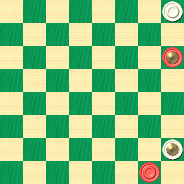
BLACK
Black to Play and Win
B:W29,K5:BK21,1.
Give the problem a "good little try" and then click on Read More to see the "little old solution."![]()
The Checker Maven is produced at editorial offices in Honolulu, Hawai`i, as a completely non-commercial public service from which no profit is obtained or sought. Original material is Copyright © 2004-2024 Avi Gobbler Publishing. Other material is the property of the respective owners. Information presented on this site is offered as-is, at no cost, and bears no express or implied warranty as to accuracy or usability. You agree that you use such information entirely at your own risk. No liabilities of any kind under any legal theory whatsoever are accepted. The Checker Maven is dedicated to the memory of Mr. Bob Newell, Sr.

